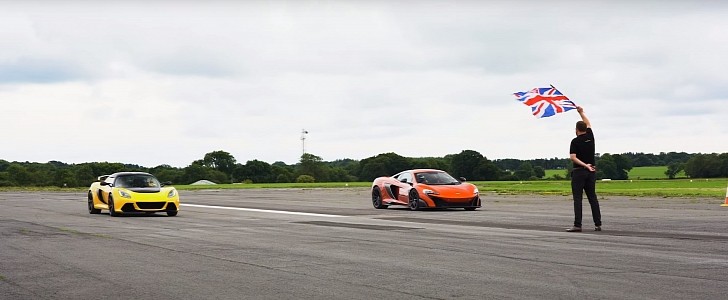The exploits of McLaren models on the drag strip are the stuff of legend. Despite their rear-wheel-drive-only configuration, which can be seen as a handicap in the shorter quarter-mile race, they pack enough top-end punch to make up for it.
On top of that, they also seem to defy numbers and logic by launching pretty hard for something that sends as much as 800 hp (in the new Senna) to a single pair of wheels. The car we have here, however, is the discontinued 675LT model producing, as the name more than suggests, 675 PS (666 hp).
Compared to the modern McLaren lineup, the 675LT is down on power. The current Long Tail develops 765 PS (754 hp), whereas the one we see the most often, the 720S, puts out - you guessed it - 720 PS (710 hp). Still, 666 hp will never be a low amount of power, especially when you look at what it's up against.
That would be a Lotus Exige V6 Club Racer, another British sports car but one that follows a very different recipe. The name "Lotus" is synonymous with being lightweight, and at just over 1.1 tons (roughly 2,400 lbs), the V6 CR certainly fits that bill. Older Exige models used to have four-cylinder engines with displacements of under two liters, but times have changed, and that kind of power just doesn't cut it anymore.
The V6 Club Racer packs a 3.5-liter supercharged unit with 350 PS (345 hp) and 302 lb-ft (410 Nm) of torque, enough to give the featherweight sports car a 0-62 mph (0-100 km/h) acceleration of four seconds and a top speed of 170 mph (273 kph).
The most important bit, though, is the fact the Lotus, being a driver's car, has a six-speed manual transmission. We all know these don't do very well in drag racing, where every split-second counts; no matter how good the driver is, they won't be able to match the milliseconds of the seven-speed automatic in the McLaren.
Well, that may be true, but there's one more aspect that needs to be taken into account: launch control. Apart from the driver's own two feet, the Lotus has none, whereas the McLaren relies on it heavily for a strong take-off. With the predictability of a light tree, knowing when to engage is simple, but when there's a guy with a flag, it gets a lot trickier. Especially when the said guy seems to favor the Lotus and lingers with his hands up for way longer than he should. And so, a star is born.
Compared to the modern McLaren lineup, the 675LT is down on power. The current Long Tail develops 765 PS (754 hp), whereas the one we see the most often, the 720S, puts out - you guessed it - 720 PS (710 hp). Still, 666 hp will never be a low amount of power, especially when you look at what it's up against.
That would be a Lotus Exige V6 Club Racer, another British sports car but one that follows a very different recipe. The name "Lotus" is synonymous with being lightweight, and at just over 1.1 tons (roughly 2,400 lbs), the V6 CR certainly fits that bill. Older Exige models used to have four-cylinder engines with displacements of under two liters, but times have changed, and that kind of power just doesn't cut it anymore.
The V6 Club Racer packs a 3.5-liter supercharged unit with 350 PS (345 hp) and 302 lb-ft (410 Nm) of torque, enough to give the featherweight sports car a 0-62 mph (0-100 km/h) acceleration of four seconds and a top speed of 170 mph (273 kph).
The most important bit, though, is the fact the Lotus, being a driver's car, has a six-speed manual transmission. We all know these don't do very well in drag racing, where every split-second counts; no matter how good the driver is, they won't be able to match the milliseconds of the seven-speed automatic in the McLaren.
Well, that may be true, but there's one more aspect that needs to be taken into account: launch control. Apart from the driver's own two feet, the Lotus has none, whereas the McLaren relies on it heavily for a strong take-off. With the predictability of a light tree, knowing when to engage is simple, but when there's a guy with a flag, it gets a lot trickier. Especially when the said guy seems to favor the Lotus and lingers with his hands up for way longer than he should. And so, a star is born.









